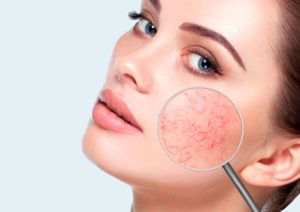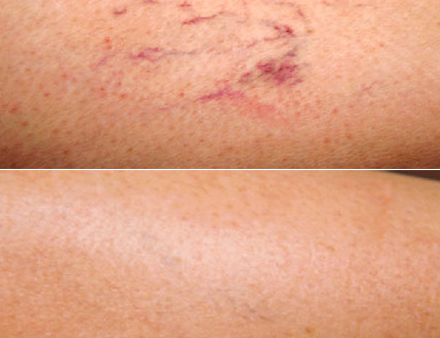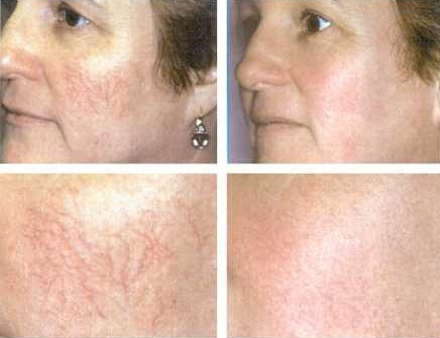
Spider vein treatment results
The rate of “resorption” of nets and veins depends on individual characteristics. In some patients, they disappear on the day of the first procedure. For others – in 3-4 days.
Small vascular networks and asterisks on the legs, pinpoint rosacea on the nose or cheeks after laser treatment disappear completely and forever after the very first procedures. And large spider veins on the face and body first lose their bright color and decrease in size. And after a course of treatment of rosacea, they completely disappear.
Thus, laser treatment of rosacea gives the following consistent results:
- Removal of spider veins on the legs and body,
- Removal of blood vessels on the face,
- Removal of telangiectasias of all shapes, types and sizes.
The likelihood of re-formation of telangiectasias is reduced to zero.
Not recommended when:
- manual face peel
- chemical peels (article – Peeling, section – Chemical peeling), laser resurfacing of the face (article – Laser resurfacing of the face)
- dermabrasion,
- vacuum cleaning
- thermal masks
- washing with hot water.
Causes of rosacea (spider veins)
Rosacea
The reasons that small vessels begin to appear in places on the face and legs of the body are quite diverse. This leads to stagnation of blood, loss of elasticity by vessels. But fragile and brittle vessels are also a consequence. And what is the cause of this unpleasant phenomenon?
According to various estimates, the causes of telangiectasia can be:
- excessive sun exposure of the skin,
- frostbite
- liver disease
- venous outflow disorders,
- clotting problems
- taking hormones and steroids,
- smoking (adversely affects the circulatory system),
- excessive exercise
- overeating.
- climatic factors (sudden temperature changes, severe frost and wind, constant exposure to the open sun),
- overly spicy and hot food,
- the abuse of coffee and dark chocolate,
- vasodilating alcohol
- stresses leading to increased blood pressure.
Moreover, the main reason for the appearance of spider veins here is a genetic predisposition and weak vessels caused by hormonal changes.
Cuperosis can also be triggered by diseases such as:
- pathology (including impaired metabolic processes) of the liver,
- gastric diseases (colitis, gastritis),
- Congenital connective tissue weakness syndrome (SCFS)
- chronic constipation
- dysbiosis,
- increased vascular wall permeability caused by vitamin C deficiency;
- hypertension,
- allergies
- rosacea.
In men, chronic venous insufficiency may be the most likely cause of rosacea. And the appearance of spider veins on the legs is the first symptom of venous disease. And it can be triggered by stagnation of venous blood in the lower extremities.
Very often, spider veins on the face and body of women appear with gynecological diseases and menopause. And in a third of them, for the first time, vasodilation appears during pregnancy or after an abortion. The connection of the occurrence of rosacea with the use of oral contraceptives was also established.
Usually, provoked by pregnancy, spider veins themselves disappear without a trace 3-6 weeks after birth. But, if they linger on the face or body longer – you need to contact specialists and remove rosacea.
Why is rosacea dangerous?

The development of skin rosacea leads not only to permanent redness, undesirable excessive blush and dry skin. Bleeding and skin lesions are possible. Which is especially dangerous if spider veins appear on the face. After all, such lesions leave numerous scars.
In addition, rosacea leads to skin aging. She does not receive the necessary amount of nutrients and oxygen, loses healthy natural color, becomes pale, acquires a grayish tint.
Spider veins on the face (telangiectasia) can also cause psychological problems, especially in women. Often, women suffering from rosacea experience protracted depression. Therefore, like any other disease, rosacea requires treatment. And you need to start treatment for telangiectasia at an early stage.
The aesthetic effect of laser removal of blood vessels and spider veins is visible immediately after the procedure.
The number of procedures for complete removal depends on the degree of damage and the size of the vessels and spider veins:
- Vessels and capillaries, having a small size, disappear after the first procedure.
To remove deeper vessels, 3-5 procedures are required with an interval of 2 to 3 weeks.















